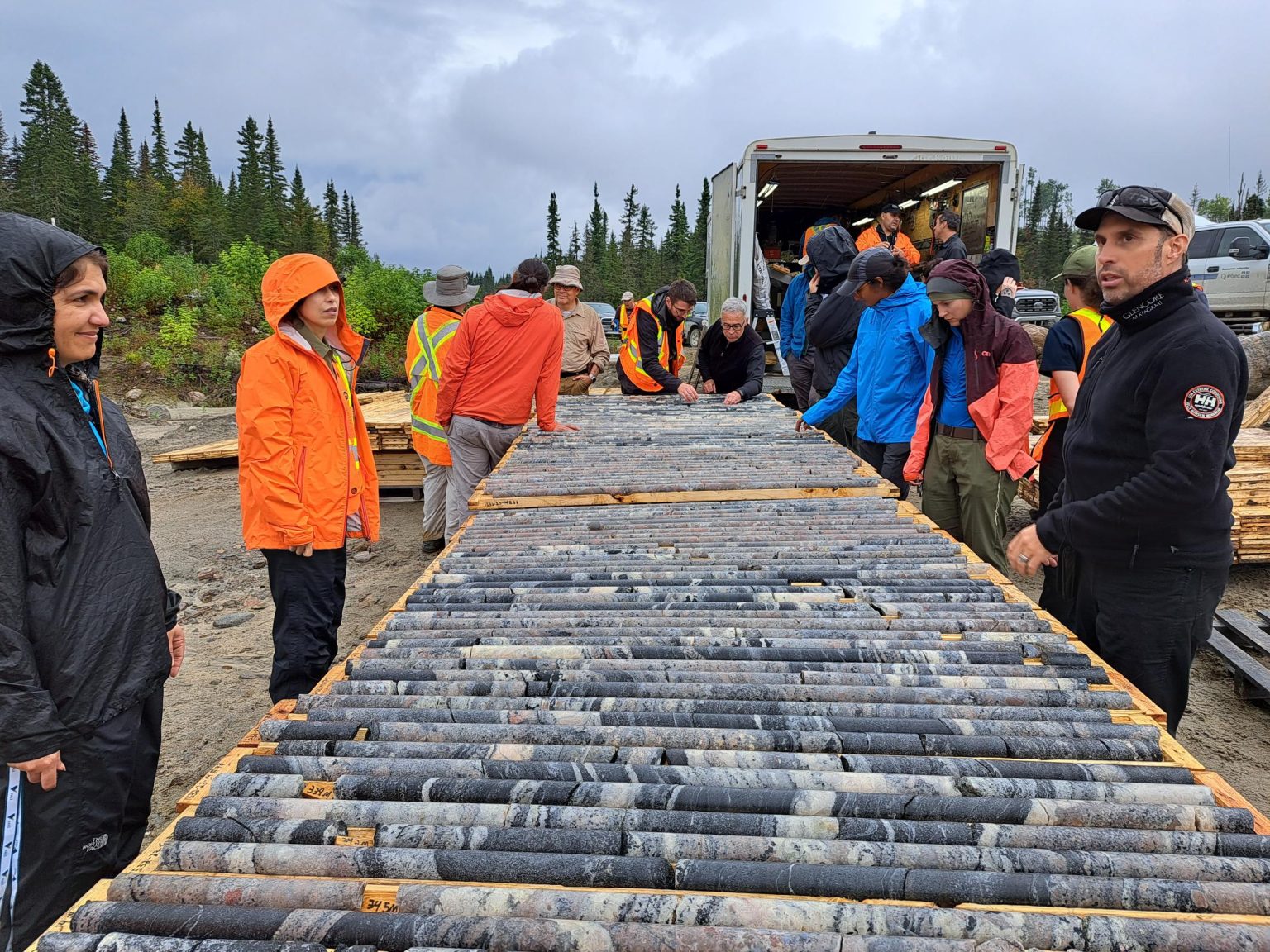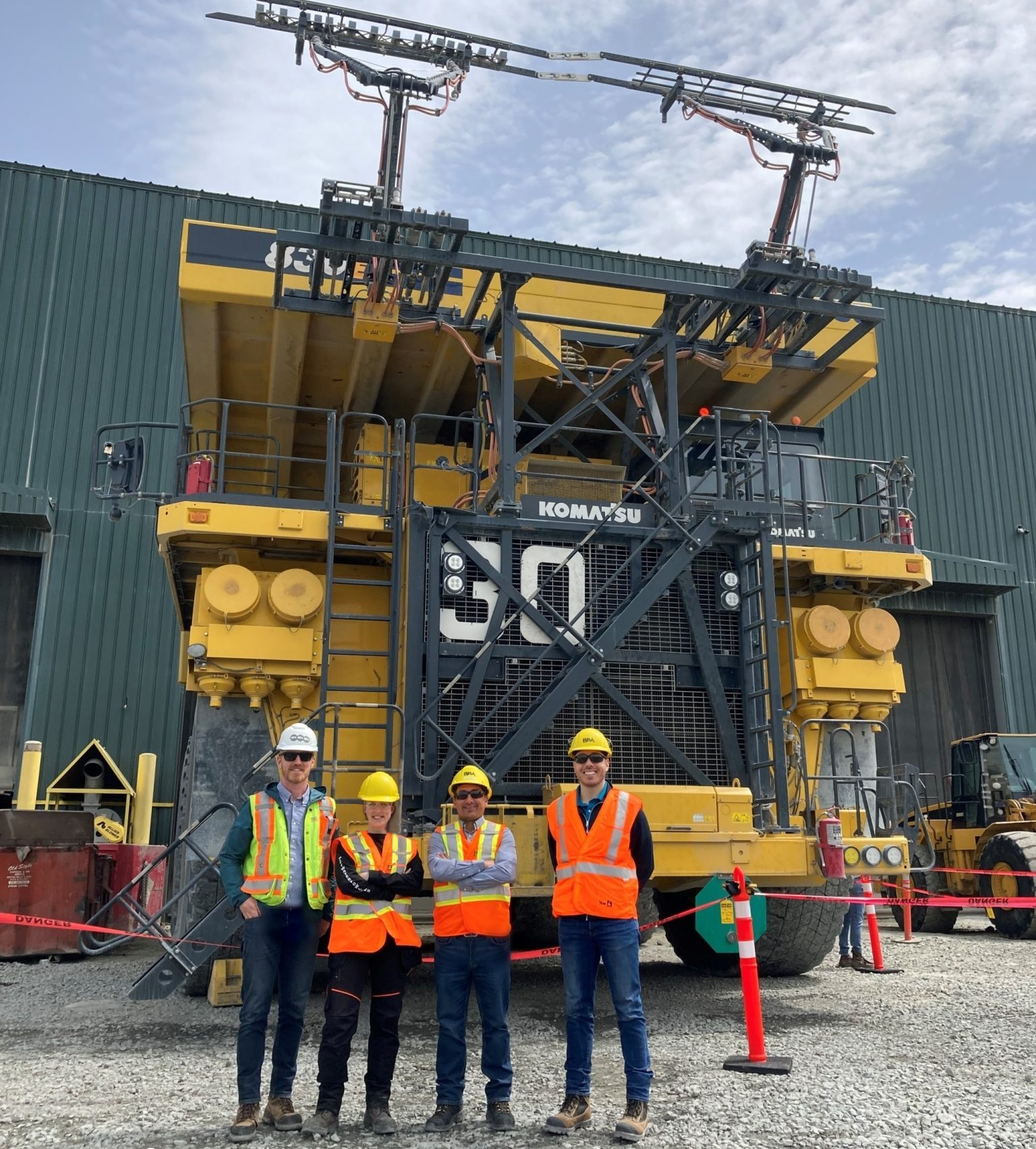Part 1 of the electric mine series: MacLean Engineering

MacLean Engineering’s battery-powered BT3 Boom Truck. CREDIT: MACLEAN ENGINEERING
There’s a “We’re hiring!” sign in front of MacLean Engineering’s Collingwood, Ont., office. The company is looking to expand most of its manufacturing facilities here, in Barrie, and in Owen Sound. It’s even difficult to find a meeting room: After leaving a conference room for a tour of the Collingwood facilities, it’s taken when we get back. Our guide, and product manager Anthony Griffiths, has to scramble to find us another meeting space.
Business is booming for MacLean, which has a 45-year history as a designer and manufacturer of mobile underground mining equipment. With a capacity to produce 14-16 units a month overall, the company can’t keep up with orders, Griffiths tells CMJ at the end of June.
“At this point, we’re booking into next year,” he says.
MacLean Engineering was founded in 1973 by Don MacLean, a mining engineer and long-time miner and entrepreneur.
Now, the chairman of the company, Don’s son Kevin MacLean, who has degrees in mechanical engineering and computer science, has served as president since 2005.
The company employs about 650 people globally, including facilities in Sudbury, Val d’Or, Thompson, Man., Creighton, Sask., Mexico, Peru, Australia and South Africa.
Its current product line includes its popular scissor bolter for ground support and utility vehicles, including boom trucks, scissor lifts, ANFO loaders and emulsion loaders. Since its founding, MacLean has delivered more than 1,200 machines to customers, including more than 500 bolters.
MacLean also has municipal, environmental and industrial product divisions, but mining comprises the bulk of its sales. Recently, the company has placed itself at the centre of one of the biggest future trends in underground mining – the elimination of diesel fuel in favour of electrification – a move that will help ensure its mining division continues to thrive in the future.
While most of the machines that MacLean makes are diesel powered, interest in the company’s new electric vehicle line, launched in 2016 with an EV version of the company’s scissor bolter, is starting to take off.
“Diesel is still the primary seller, but that’s changing, slowly but surely,” says Griffiths, who is MacLean’s sales product manager for electrification. “Based on what we’re seeing from customers, I would say 2020 will probably be the real tipping point.
It’s certainly started – we’ve been in discussions with just about every major mining company.”
The company is getting ready – by the end of 2018, battery powered versions of its complete fleet will be available to purchase.
Goldcorp ‘put us on the map’
Griffiths credits a lot of the interest in MacLean’s EV line to Goldcorp, which committed in 2016 to building Canada’s first all-electric mine at its Borden gold project in Chapleau, Ont.
“Goldcorp really was the one that sort of took the leap of faith. They jumped out and said we’re going to buy this stuff – we don’t want to talk about it, we want to buy it.”
Goldcorp’s order for EV equipment “put us on the map,”
Griffiths adds. The gold miner ordered six units to start, followed by a second order for nine units. They include MacLean’s 975 scissor bolters, CS3 cassette carriers, SL3 scissor lifts and a BH3 blockholer.
In addition, Goldcorp has another EV unit at its Musselwhite mine in northern Ontario, and Vale has just bought one for its Sudbury basin operations. MacLean also has three demo units, for a total of 20 EV units all together (nine are scissor bolters and the rest boom trucks, scissor lifts, emulsion loaders).
“It’s pretty exciting the interest we’re gathering,” Griffiths says. “Just this week we’ve been contacted by projects in the United States, South America, and Europe. It’s coming in from all over – it’s not just Canada .”
While cost pressures of ventilation – especially as mines go deeper – and safety concerns about exposure of workers to diesel particulates are driving underground mines toward battery powered fleets, recent developments in battery technology are now making it possible for suppliers to manufacture powerful, safe, reliable and efficient battery powered equipment that speaks to those concerns.
MacLean is not alone in working on an EV line, but it is one of the first to have a commercialized product ready for the market.
Starting in 2015, it only took a year of development for the company to produce its first EV unit – a process some observers said would take closer to five.
“We’re a very entrepreneurial based company, we’re pretty nimble, and we don’t have a huge amount of people,” Griffiths says, adding that there aren’t a lot of layers of decision making.
“It was quite an achievement, and that was basically because we knew the order was coming (from Goldcorp). So in some ways that was good because it forced us to get it done.”

The MacLean 975 Omonia Bolter. CREDIT: MACLEAN ENGINEERING
First principles
In developing its EV series, Maclean stuck to several “first principles” to ensure the line’s success. First, any battery system it adopted had to work with the company’s existing machines so that they could be retrofitted. The systems had to be compatible with existing power supply and voltage requirements in mines, so customers would not need to build any additional infrastructure to use the technology. Third, the system had to be flexible so that emerging technology could be incorporated. And finally, the system had to perform at least as well as – if not better than – diesel-powered machines.
To achieve all of this, MacLean worked with the Collingwood- based engineering firm MEDATech to source and integrate best-in-class EV drive components into the MacLean equipment line, rather than buying a complete system.
“We wanted to be able to buy the best-in-class batteries, best-in-class chargers, the best motors,” said Griffiths.
Rather than asking its customers to change out depleted batteries for fully charged ones, MacLean also wanted to go with on-board charging to make the machines as easy to use as possible and reduce costs.
The company’s chosen batteries were sourced from a German supplier whose lithium-nickel-manganese-cobalt product is used in buses, trains, heavy trucks and other applications in Europe. “A lot of battery suppliers that came to us really didn’t have any kind of track record – these guys have been in business for over 20 years.”
The batteries consist of three battery trays of 30.67 kW each that are then stacked up into a package to form the battery core.
“All of our units right now are based on three trays, but we can expand or shrink that as required by the duty cycle, so our system is very scalable and adaptable – it’s not one size fits all.”
In addition to high energy density and a long life cycle, the batteries have a sophisticated thermal management system.
“We can control the temperature and the temperature spikes inside the battery cell itself through this heating and cooling system – so you certainly lessen the risk of any kind of thermal flare up with the batteries.”
A battery monitoring system keeps track of the temperature of each battery cell, the energy it’s discharging, when it was charged and how big a charge it received. It can also tell the operator how the battery is performing and whether it’s being charged correctly.
Currently the data is contained in a manual data logger on the battery, and it gets manually downloaded to a memory stick, then into a computer. That’s just an interim step, however, with MacLean working on Wi-Fi capability.
Charge times and how long the charge will last depends on how the machine will be used – if it’s at the face working, for example, it can be more easily recharged than if it’s being driven a lot.
The system’s regenerative braking capability gives the battery a re-charge of up to 35% when going down ramp.
Also, if four battery chargers are used instead of three, charge times can be shortened to as little as 35 minutes, making it possible to fully charge a vehicle over lunch, for example.
A trial completed at Glencore’s Nickel Rim South mine in Sudbury last fall showed that a boom truck on a 65% charge was able to complete four runs down and up a 2.5-km ramp carrying 16 bags of shotcrete before needing to be charged. In a second test, the operator used the 10-minute opportunity available while the truck was being unloaded to plug the machine in for a partial charge, then did a full charge over lunch. In that instance, the operator was able to complete six runs before lunch and six runs after lunch over a 10-hour period.
“We went from four cycles to twelve, never really needing a full blown charge, so that made it much more economical and it tied in with what the operator was doing. He’s loading the deck, the vehicle is idle, so take that opportunity to plug in and charge,” Griffiths says.
“The battery really likes to be at 50%, so that’s the ideal state.
Anything on either side of that 50% is the optimum – energy in, energy out and it preserves the life of your battery. In this case, the highest we ever went was just under 85% and the lowest was around 40% – so that’s right in the sweet spot.”
Cost of ownership
While there is a premium on EV units, the cost of ownership is actually competitive with diesel units. For a BT3 Boom Truck, the modelled total cost per hour comes to $102.61, compared to $105.93 for a Tier 3 unit and $115.80 for a Tier 4 unit. This doesn’t include savings on fuel or ventilation – costs are only compared on operating the unit.
“The biggest savings is in maintenance – all your scheduled maintenance, parts, changing your filters, oils, all that stuff goes away. If you’re not maintaining your vehicle, it’s being used, which provides an uptime in your vehicle availability and your return,” notes Griffiths.
The savings are much higher if you factor in the cost of diesel and ventilation, however. “When you tie in the ventilation and the elimination of the diesel particulate, the battery unit really looks like the right choice.”
As MacLean gears up for the tipping point in EVs, it’s also planning the next advances in its machines.
“There’s a big push on right now for automation and connectivity to the internet, so vehicle monitoring, vehicle location – we’re devoting a lot of time and energy to that.”





Comments